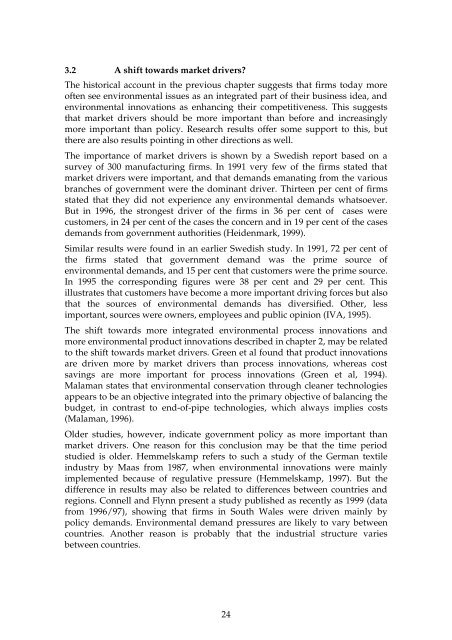Drivers of environmental innovation - Vinnova
Drivers of environmental innovation - Vinnova
Drivers of environmental innovation - Vinnova
You also want an ePaper? Increase the reach of your titles
YUMPU automatically turns print PDFs into web optimized ePapers that Google loves.
3.2 A shift towards market drivers?<br />
The historical account in the previous chapter suggests that firms today more<br />
<strong>of</strong>ten see <strong>environmental</strong> issues as an integrated part <strong>of</strong> their business idea, and<br />
<strong>environmental</strong> <strong>innovation</strong>s as enhancing their competitiveness. This suggests<br />
that market drivers should be more important than before and increasingly<br />
more important than policy. Research results <strong>of</strong>fer some support to this, but<br />
there are also results pointing in other directions as well.<br />
The importance <strong>of</strong> market drivers is shown by a Swedish report based on a<br />
survey <strong>of</strong> 300 manufacturing firms. In 1991 very few <strong>of</strong> the firms stated that<br />
market drivers were important, and that demands emanating from the various<br />
branches <strong>of</strong> government were the dominant driver. Thirteen per cent <strong>of</strong> firms<br />
stated that they did not experience any <strong>environmental</strong> demands whatsoever.<br />
But in 1996, the strongest driver <strong>of</strong> the firms in 36 per cent <strong>of</strong> cases were<br />
customers, in 24 per cent <strong>of</strong> the cases the concern and in 19 per cent <strong>of</strong> the cases<br />
demands from government authorities (Heidenmark, 1999).<br />
Similar results were found in an earlier Swedish study. In 1991, 72 per cent <strong>of</strong><br />
the firms stated that government demand was the prime source <strong>of</strong><br />
<strong>environmental</strong> demands, and 15 per cent that customers were the prime source.<br />
In 1995 the corresponding figures were 38 per cent and 29 per cent. This<br />
illustrates that customers have become a more important driving forces but also<br />
that the sources <strong>of</strong> <strong>environmental</strong> demands has diversified. Other, less<br />
important, sources were owners, employees and public opinion (IVA, 1995).<br />
The shift towards more integrated <strong>environmental</strong> process <strong>innovation</strong>s and<br />
more <strong>environmental</strong> product <strong>innovation</strong>s described in chapter 2, may be related<br />
to the shift towards market drivers. Green et al found that product <strong>innovation</strong>s<br />
are driven more by market drivers than process <strong>innovation</strong>s, whereas cost<br />
savings are more important for process <strong>innovation</strong>s (Green et al, 1994).<br />
Malaman states that <strong>environmental</strong> conservation through cleaner technologies<br />
appears to be an objective integrated into the primary objective <strong>of</strong> balancing the<br />
budget, in contrast to end-<strong>of</strong>-pipe technologies, which always implies costs<br />
(Malaman, 1996).<br />
Older studies, however, indicate government policy as more important than<br />
market drivers. One reason for this conclusion may be that the time period<br />
studied is older. Hemmelskamp refers to such a study <strong>of</strong> the German textile<br />
industry by Maas from 1987, when <strong>environmental</strong> <strong>innovation</strong>s were mainly<br />
implemented because <strong>of</strong> regulative pressure (Hemmelskamp, 1997). But the<br />
difference in results may also be related to differences between countries and<br />
regions. Connell and Flynn present a study published as recently as 1999 (data<br />
from 1996/97), showing that firms in South Wales were driven mainly by<br />
policy demands. Environmental demand pressures are likely to vary between<br />
countries. Another reason is probably that the industrial structure varies<br />
between countries.<br />
24

















